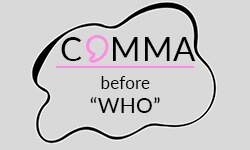
Comma placement can be a challenging task for many students, particularly in academic writing. This is often because they may not be properly aware of the rules and exceptions that apply to the usage of commas. In this article, we aim to help clarify one instance where comma placement can become tricky. We provide examples and explain the exceptions to the rules of when to use a comma before “who.” Moreover, we offer a practice sheet for students to test their understanding.
When to place a comma before “who”
“Who” is a relative pronoun mostly used to introduce a question about identity, such as asking about a person’s name, occupation, or other characteristics. “Who” is also used in relative clauses to provide additional information about a person or people. A comma before “who” should be placed if the clause introduces non-essential information. No comma before “who” is required when the word either introduces an indirect question or an essential clause.
Comma
Non-essential clause
No comma
Indirect question
Essential clause
It’s important to note that the rules regarding the use of a comma before “who” can vary depending on the style guide being followed. Additionally, there may be exceptions and variations based on specific contexts or personal writing preferences. Writers should consult the relevant style guide or consider the specific context to determine the appropriate usage.
Comma before “who”
In certain grammatical constructions, the decision to use or omit a comma before “who” can significantly impact the clarity and meaning of a sentence. Understanding when to employ a comma before “who” is crucial for accurate punctuation and effective communication. This section explores the guidelines and considerations associated with the placement of commas before the pronoun “who” in different contexts.
Non-essential clause
A comma before “who” is needed when it introduces a non-essential or non-restrictive clause. This comma signals that the information in the clause is additional and can be omitted without changing the essential meaning of the sentence. Non-essential clauses provide extra details, but are not necessary for identifying the noun they modify. Here are three examples to illustrate the use of a comma before “who” in non-essential clauses.
No comma before “who”
In specific contexts, the absence of a comma before “who” is essential for maintaining clarity. Therefore, understanding when not to use a comma before “who” is crucial in conveying the precise meaning and identifying the noun in question. This section explores the two instances where refraining from using a comma before “who” is grammatically appropriate and improves sentence structure.
Indirect question
No comma before “who” is required when it introduces an indirect question. In indirect or reported questions, the clause is typically considered an essential or restrictive element, and the absence of a comma helps maintain the flow and connection between the clauses.
Essential clause
No comma before “who” is required when it introduces an essential or restrictive clause because, in this context, the information is crucial for identifying or specifying the noun it modifies. Omitting the comma helps to indicate that the clause is necessary for the overall meaning of the sentence.
Special case: Comma after “who”
A comma after “who” is only used when there is an aside or a parenthetical phrase between “who” and the information that follows it.
Test yourself!
Practice sheet
In the following sentences, we provide practice sentences for using commas before “who.” Check the solutions in the second tab named “answers.”
- I have a friend who between you and me, can be quite stubborn at times.
- We need someone who is an expert in data analysis and can guide us.
- Can you tell me who the author of that book is?
- My best friend who is an accomplished pianist, will be performing at the concert.
- I want to know who the winner of the competition will be announced tomorrow.
- The student who won the scholarship, is studying abroad.
- Do you know who the person sitting in the corner is?
- The manager who recently joined the company, is implementing new policies.
- He couldn’t remember who the actress in the movie played the lead role.
- The author who has published multiple bestsellers, will be signing books at the event.
- I have a friend, who, between you and me, can be quite stubborn at times. (Comma)
- We need someone who is an expert in data analysis and can guide us. (No comma)
- Can you tell me who the author of that book is? (No comma)
- My best friend, who is an accomplished pianist, will be performing at the concert. (Comma)
- I want to know who the winner of the competition will be announced tomorrow. (No comma)
- The student, who won the scholarship, is studying abroad. (Comma)
- Do you know who the person sitting in the corner is? (No comma)
- The manager, who recently joined the company, is implementing new policies. (Comma)
- He couldn’t remember who the actress in the movie played the lead role. (No comma)
- The author, who has published multiple bestsellers, will be signing books at the event. (Comma)
Printing Your Thesis With BachelorPrint
- High-quality bindings with customizable embossing
- 3D live preview to check your work before ordering
- Free express delivery
Configure your binding now!
FAQs
Yes, a comma is used before “who” in non-essential clauses.
“Who” can be used in the middle of a sentence as a relative pronoun to introduce a clause that provides additional information about a noun or to introduce a question.
“Who” is grammatically used as a relative pronoun to introduce a clause that identifies or describes a person or people.
Yes, a sentence can start with “who” when it is used as a relative pronoun to introduce a relative or dependent clause or question.
